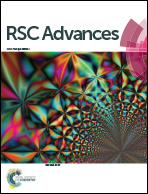Highly efficient visible-light photocatalysts: reduced graphene oxide and C3N4 nanosheets loaded with Ag nanoparticles
Abstract
In the current study, the degradation of methyl orange under visible-light irradiation was performed to gain an insight into the performance of the novel Ag/C3N4/reduced graphene oxide photocatalyst (Ag/C3N4/RGO). Using N,N-dimethylformamide (DMF) as an effective reducing agent as well as solvent, Ag nanoparticles were well anchored on C3N4/RGO nanosheets, which were prepared by a facile hydrothermal reaction. Inexpensive, stable C3N4 was coupled with well-conductive RGO and the plasmon resonance effect of Ag exhibited higher activities compared with pure C3N4, C3N4/RGO, Ag/RGO, and Ag/C3N4, respectively. The presence of Ag and RGO was confirmed by FTIR, XRD, and TEM, and their influence on the activity of C3N4 was demonstrated with the photocatalytic results, detection of reactive species and mechanism analysis. The photoluminescence spectra (PL) and the transient photocurrent response were also tested to determine the enhanced separation of photogenerated charge carriers. The facile synthesis of Ag/C3N4/RGO, together with their superior catalytic performance, successfully provide a promising route for the rational design of comparatively inexpensive and highly active C3N4-based ternary nanostructured composites.


 Please wait while we load your content...
Please wait while we load your content...